In my first article in this series I covered the generalities and historic background of the Vatican Necropolis. Go back and read it if you haven’t!
 In this second post I’ll cover the mausoleums in the underground tour under Saint Peter’s Basilica, one by one with the its highlights.
In this second post I’ll cover the mausoleums in the underground tour under Saint Peter’s Basilica, one by one with the its highlights.
I hope this compendium will bring us closer to the people who built these tombs, the care they poured into these family spaces commissioning the decoration and the architecture, the dedication and the sentiment in making these the best place possible for their dead.
And ultimately, let us go back in time in a walk up the Vatican Hill, to finally reach the tomb of Saint Peter, Jesus right hand man.
The mausoleums at the Vatican Necropolis
According to the Open University’s course about ancient Roman funerary monuments family was important for the ancient Romans.
One way to preserve the name of the family was to build a family tomb.
Though most Romans could not afford one, many built them for their nuclear family of husband, wife and children.
Poor Romans would be buried in mass graves or small tombs marked on the ground with modest markers or amphorae.
The size, extent of decoration and inclusion of architectural elements had a direct relation to the social status of the family.
During the first century AD the deceased were cremated and their remains put into containers or urns that were placed in small niches (columbarium) inside the family tomb
I will be using a Vatican Necropolis floorplan along the way, so that you know exactly where you are. Here we go!
Mausoleum A
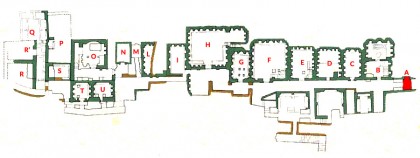 This is where the tour starts. The mausoleum of Caius Polilius Heracla contains a tablet in which the existence of the nearby arena (Nero’s circus) is mentioned.
This is where the tour starts. The mausoleum of Caius Polilius Heracla contains a tablet in which the existence of the nearby arena (Nero’s circus) is mentioned.
Mausoleum B
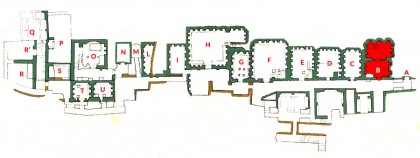 It belonged to Fannia Redempta, the wife of Aurelius Hermes, a freeman of the Augusti family who highlights his wife as “incomparable”.
It belonged to Fannia Redempta, the wife of Aurelius Hermes, a freeman of the Augusti family who highlights his wife as “incomparable”.
The walls have niches where the ashes were stored in urns, which indicate a pagan (different from the main religions of the world) burial.
The painting on the vault is of a “Sun Chariot” accompanied by figures of the seasons. The rest of the tomb is decorated with paintings of flowers and animals.
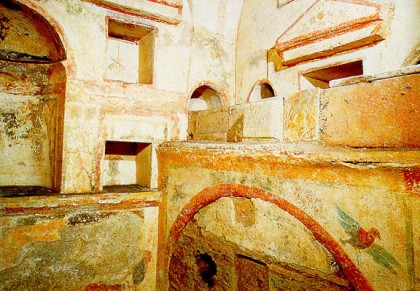
Interior of mausoleum B. Photo: saintpetersbasilica.org
Mausoleum C
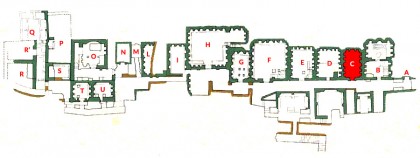 This is the tomb of L. Tullius Zethus. The L preceding the name implies he was a freed slave or his father had been. He must’ve done pretty well for himself since this tomb is one of the most ornate with wall decorations and mosaic floor.
This is the tomb of L. Tullius Zethus. The L preceding the name implies he was a freed slave or his father had been. He must’ve done pretty well for himself since this tomb is one of the most ornate with wall decorations and mosaic floor.
Two marble urns were added at a later period. The tomb has niches for urns and two arcosolia (a recess on the wall in the form of an arc, used as grave).
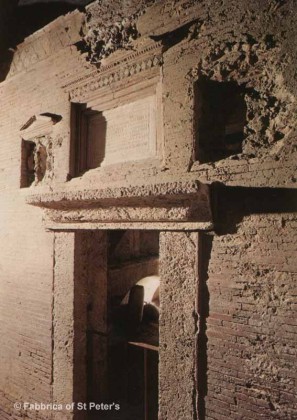
Entrance to mausoleum C.
Photo: Fabbrica of Saint Peter’s
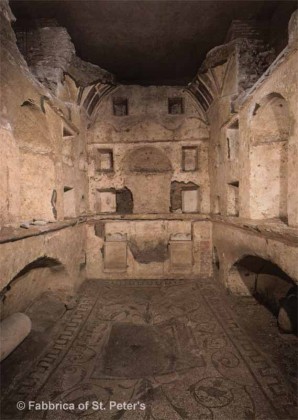
Interior of mausoleum C.
Photo: Fabbrica of Saint Peter’s
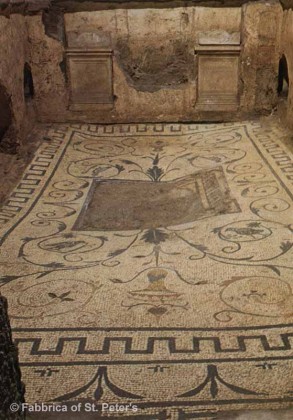
Detail of the mosaic floor in mausoleum C.
Photo: Fabbrica of Saint Peter’s
Mausoleum D
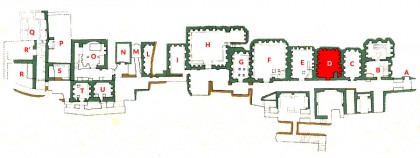 We don’t know who it belonged to. It’s called Mausoleum of the opus reticulatum, named after the pattern in which the bricks have been placed.
We don’t know who it belonged to. It’s called Mausoleum of the opus reticulatum, named after the pattern in which the bricks have been placed.
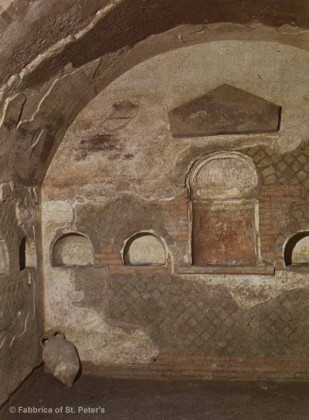
Interior of mausoleum D.
Photo: Fabbrica of Saint Peter’s
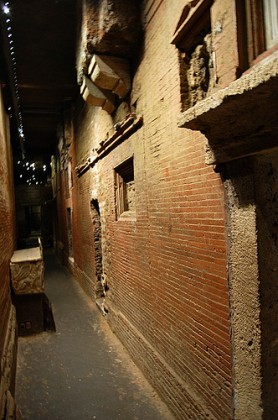
A street in the Vatican Necropolis.
Photo: Catholic Eye Candy cathcandy.wordpress.com
Mausoleum E
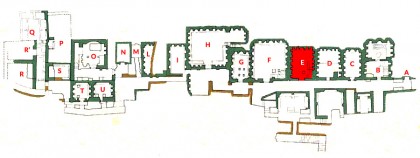 This is the tomb of T. Aelius Tyrannus, a freedman who worked in public office. The most notable elements of this tomb are two alabaster containers, one with a Medusa carving and the stucco paintings on the walls.
This is the tomb of T. Aelius Tyrannus, a freedman who worked in public office. The most notable elements of this tomb are two alabaster containers, one with a Medusa carving and the stucco paintings on the walls.
As with other tombs there are niches and arcosolia… but observe also the staircase that was used to go up to and down from the upper room which was used for the “refrigerio” a rite in which family accompanied the deceased in a sort of feast.
The family go down to the inner burial room to pour libations (offerings of food and wine) through holes on the floor, to feed the deceased.
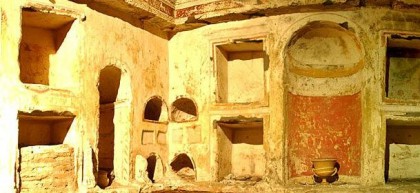
Detail of Mausoleum E. Photo: www.vatican.va
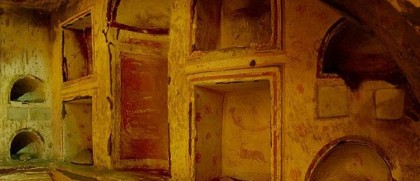
Detail of Mausoleum E. Photo: www.vatican.va
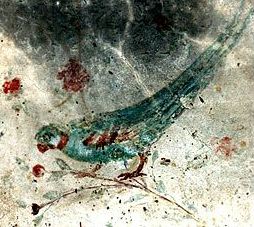
Detail of a parrot in Mausoleum E.
Photo: www.vatican.va
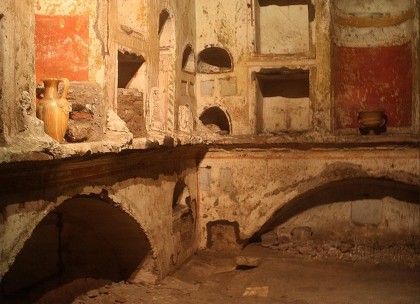
Interior of Mausoleum E with alabaster containers. Photo: Blanca & Ian’s Travels, members.rennlist.com/imcarthur/roma.htm
Mausoleum F
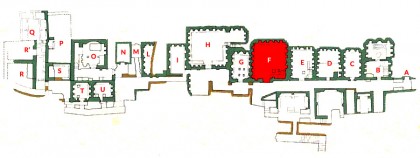 The first to be discovered in 1939, this is the tomb of the Tulli and the Caetenni as it is stated on the altar that stands in the middle of the mausoleum.
The first to be discovered in 1939, this is the tomb of the Tulli and the Caetenni as it is stated on the altar that stands in the middle of the mausoleum.
This is a pagan tomb with some Christian symbolism. The woman mentioned in the altar is Emilia Gorgonia, and her husband mentions her beauty and goodness.
The holes for the libations are visible on the right side of the floor. Romans held funeral banquets in which wine and food were poured inside these holes, for the deceased to be fed.
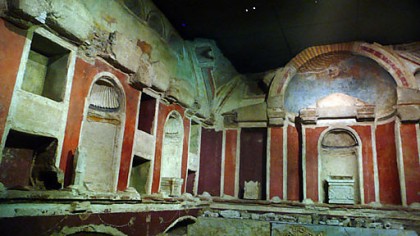
Interior of Mausoleum F. Photo: BBC. Vatican: The Hidden World.
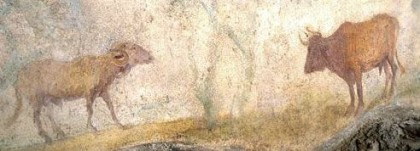
Detail of sheep and bull on the left wall of Mausoleum F.
Photo: www.vatican.va
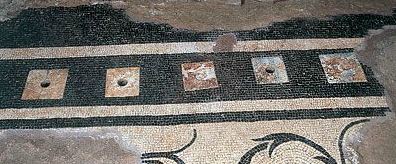
Holes for the libations on the mosaic floor of Mausoleum F.
Photo: www.vatican.va
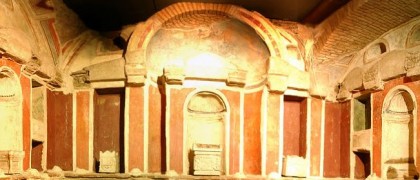
Interior of Mausoleum F, Vatican Necropolis. Photo: www.vatican.va
Mausoleum G
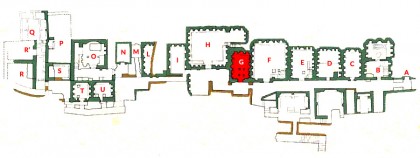 The Tomb of the Teacher is named after the painting in the back wall depicting an old man with a scroll, in front of a younger man.
The Tomb of the Teacher is named after the painting in the back wall depicting an old man with a scroll, in front of a younger man.
It is most likely an administrator and a servant, though the first people who saw the tomb interpreted the painting as a teaching and his student.
The ceiling depicts beautiful paintings of animals, garlands and geometric figures. Can you imagine the artist painting these figures with so much care and attention?
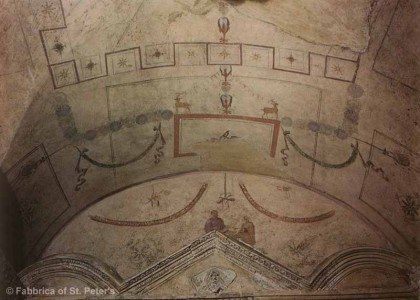
Interior of Mausoleum G. Photo: Fabbrica of Saint Peter’s
Mausoleum H
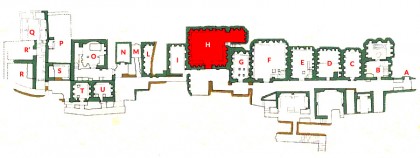 The Tomb of the Valerii is the most luxurious of all the tombs. It belonged to Valerius Philumenus and Valeria Galatia who gave permission to several members of their family and some friends, to use this mausoleum.
The Tomb of the Valerii is the most luxurious of all the tombs. It belonged to Valerius Philumenus and Valeria Galatia who gave permission to several members of their family and some friends, to use this mausoleum.
Several marble portraits (including some children) were found in it. See a couple of them on the bottom-right corner of this picture?
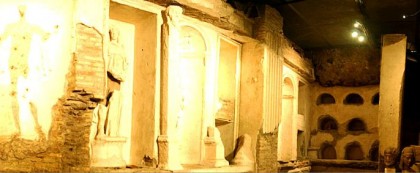
Interior of Mausoleum H. Photo: www.vatican.va
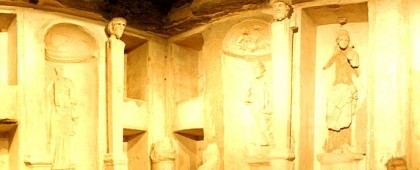
Interior of Mausoleum H. Photo: www.vatican.va
Mausoleum I
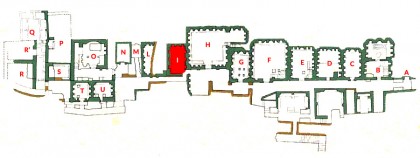 The Tomb of the Chariot from the quadriga figure in the mosaic floor that depicts the rape of Persephone by Pluto on a chariot driven by Mercury.
The Tomb of the Chariot from the quadriga figure in the mosaic floor that depicts the rape of Persephone by Pluto on a chariot driven by Mercury.
The fresco paintings depict birds, a peacock (a symbol of afterlife), ducks, doves and floral designs.
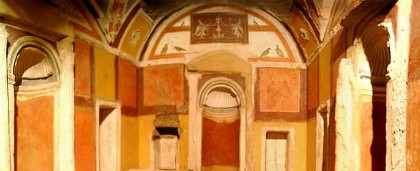
Interior of Mausoleum I. Photo: www.vatican.va
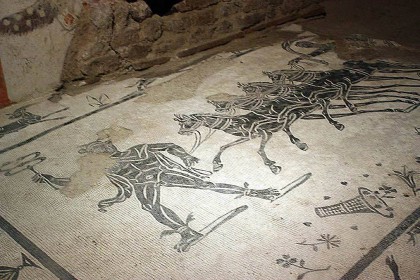
Detail of the Chariot mosaic on the floor. Photo: Blanca & Ian’s Travels, members.rennlist.com/imcarthur/roma.htm

Detail of the peacock. Photo: www.vatican.va
Mausoleum M
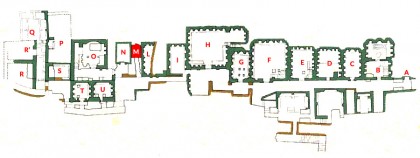 The tomb of the Julii or “Cristo Sole“, Christ the Sun or the Christan Mausoleum. This tomb was built by the parents of Julius Tarpeianus.
The tomb of the Julii or “Cristo Sole“, Christ the Sun or the Christan Mausoleum. This tomb was built by the parents of Julius Tarpeianus.
Even though the shape and some elements of the tomb are pagan, the mosaics are Christians depicting a scene of Jonah being eaten by the whale and a scene of a fisherman.
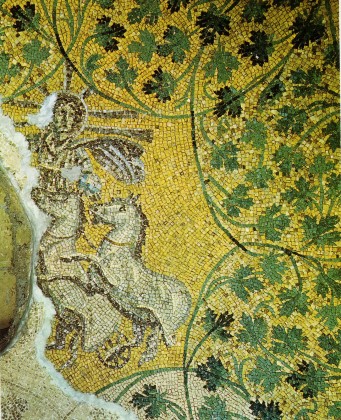
The Cristo Sole.
Photo: counterlightsrantsandblather1.blogspot.com
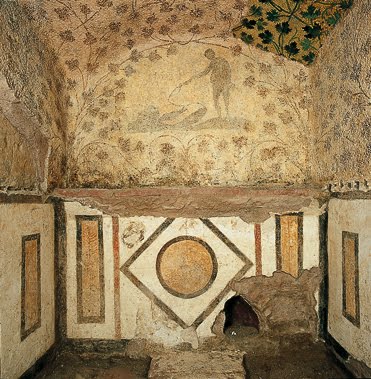
Detail of the fisherman. Photo: sacredportals.blogspot.com
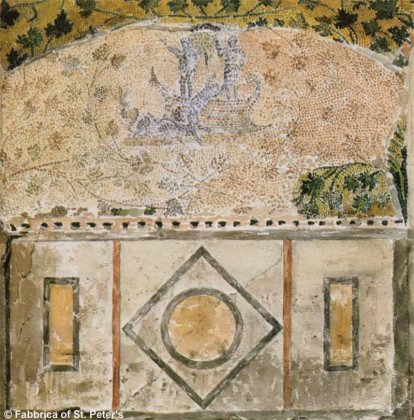
Detail of Jonah. Photo: Fabbrica of Saint Peter’s
Mausoleum N
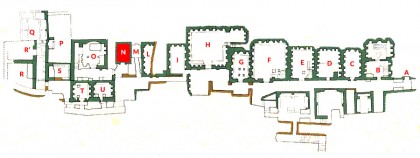 The tomb of Aebutius also bears the name of “Clodius Romanus“. His mother calls him her “most gentle son” on the epitaph of the urn.
The tomb of Aebutius also bears the name of “Clodius Romanus“. His mother calls him her “most gentle son” on the epitaph of the urn.
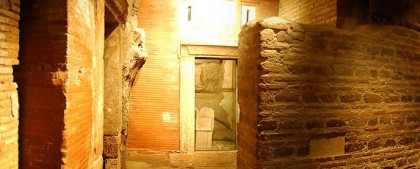
Entrance to Mausoleum N. Photo: www.vatican.va
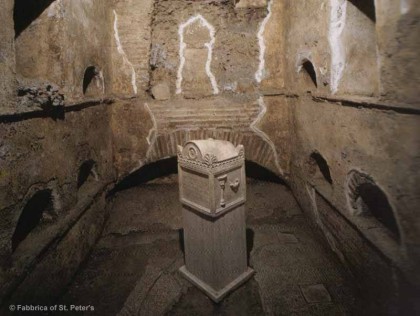
Interior of Mausoleum N. Photo: Fabbrica of Saint Peter’s
Mausoleum U
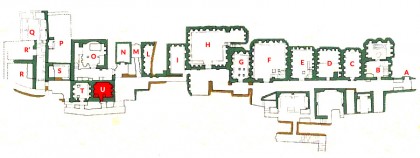 A reduced tomb, you can only see a small detail of a painted “light-bearer”.
A reduced tomb, you can only see a small detail of a painted “light-bearer”.

Detail of interior of Mausoleum U. Photo: www.vatican.va
Mausoleum T
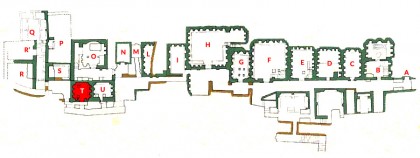 The Tomb of Trebellena Flaccilla is decorated with delicate painting of birds and flowers. There’s also a detail of a dolphin.
The Tomb of Trebellena Flaccilla is decorated with delicate painting of birds and flowers. There’s also a detail of a dolphin.
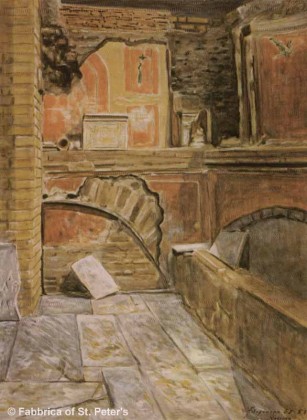
Interior of Mausoleum T.
Photo: Fabbrica of Saint Peter’s
Mausoleum S
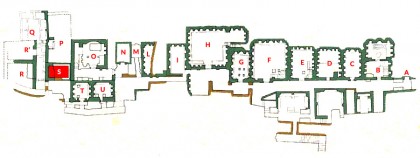 This tomb has been largely occupied by the foundations to Bernini’s Baldaquino (the canopy above).
This tomb has been largely occupied by the foundations to Bernini’s Baldaquino (the canopy above).
Mausoleum S is very important because it’s located on the south of Field P and beyond it, there’s a small corridor called the “Clivus” that runs from south to north meeting the “Red Wall” at the northeast side.
You need to remember these three terms for the next post, because here, we are entering the Tomb of Saint Peter itself.
But for that, we need an even more thorough explanation. So look out for my next article!
We’re almost there!
By now we have walked up the slope of the Vatican Hill, south to north, going through the remains of a cemetery for wealthy Romans.
We have imagined how they remembered their dead and how they celebrated life with their rituals and the ornate decorations that cemented their family tomb.
Have you ever visited other Roman cemeteries? What was the experience like?
How do they relate to the way we see death now and our own rituals?
Share your thoughts in the comments field and join the conversation in Facebook!
Practicalities
- When planning a trip to the Vatican Necropolis, make reservations well in advance, between 30 to 90 days before due to reduced availability.
- Send an email to scavi@fsp.va
- They’ll respond asking for your full name (and those in your party), nationalities, home address and number, age and language you prefer for the tour.
- You are not allowed to make reservations for other people (unless they are your party and you’re going with them to the tour).
- Entrance fee is about 12 Euro and you are asked to pay them via credit card before making your reservation.
- No cameras, food or big bags allowed. There are places where you can store them on the sides of Saint Peter’s Square.
- A very strict dress code is enforced. No bare shoulders, no skirts above the knee and no shorts, the Necropolis is considered a holy place.
- The Scavi is open from 9:15 to 3:30 pm Mon-Sat except on Vatican holidays.
- The tour lasts about 60-90 minutes and it is completely underground.
- On the appointment date approach the Swiss Guards on the left side of Saint Peter’s Square. They’ll direct you to the Ufficio Scavi (Excavation Office).
- Be there at least 10 minutes before the hour in your confirmation email, to receive your tickets.
- People under 15 are not allowed. No more than 12 people per group.
- People who pay for the tour of the Vatican Necropolis, can enter Saint Peter’s Basilica right afterwards without having to get in line!
Additional resources
- First article of this series: “The secret under Saint Peter’s Basilica in the Vatican”.
- Visit the FAQ page of the Scavi.
- Amazing Virtual 360° tour of the Vatican Necropolis
- Short course about ancient Roman funerary monuments course from the Open University.
- First and third articles in this series about the Vatican Necropolis.



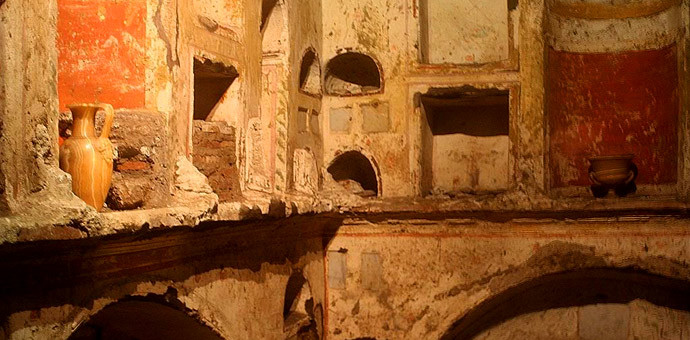
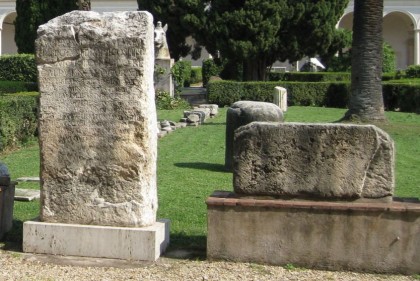
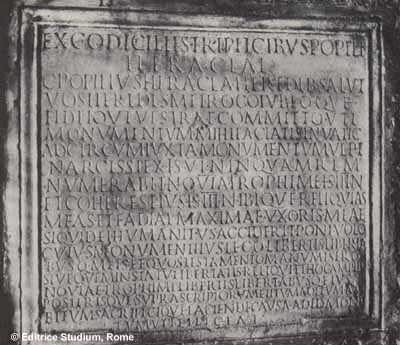
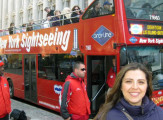
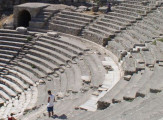
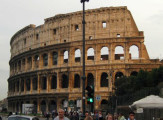
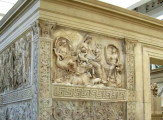

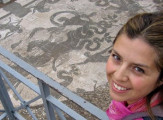


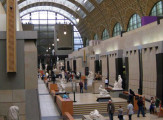
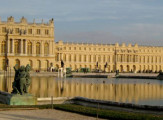


















I was here many years ago. I had memorized the view of the trophy from a book written by the actual archaeologists who did the excavating. The person in charge of the Knights of Columbus Library wanted to buy this book, but I would not sell it. When I stood in front of the grave, I had no idea of what I was looking at. It looked like a jumble of walls and rocks.
I was the last person to leave the group and for a few seconds, I stood looking up through a hole in the ceiling and up through another hole in the floor above to see I was standing at the exact center of the Great Dome, The dome is centered over this spot before the trophy.
Very remarkable trip, besides having my pockets picked just outside Vatican city. It was poring rain and we all had to wait outside the basilica.by a Swiss guard station. He called me over and pointed for me to stand in his box out of the rain. I was the only one he called over.
It’s definitely an incredible experience. I hope to be back one day. Thanks for your comment, Robert!